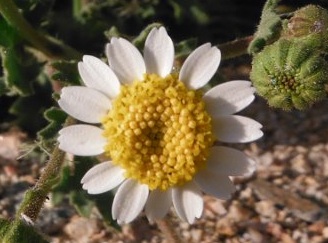
|
Rock Daisy
January/February
Rock daisy is one of the most dependable bloomers that grow in the desert
in and around the Death Valley area below an elevation of 5000 feet. Most
often growing at the base of rocks by the side of a wash, even during dry
years plants are likely to yield attractive flowers. Producing white ray
flowers around a dense cluster of yellow disk flowers, rock daisy in many
ways epitomizes the prototypical daisy plant. Although highly variable,
rock daisy typically grows to a height of no more than eighteen inches.
(Click here for more info!)
|

|
Silver Cholla
March/April
There are a number of different species of cholla that are native to the
Death Valley area, but the species that you are most likely to encounter at
higher altitudes in the Death Valley area is Silver Cholla. In fact, the
specimen shown here was photographed in Pleasant Canyon at and elevation of
6600 feet. Despite the attractive appearance of the flowers produced by
Silver Cholla, it is said that they produce a rather unpleasant odor
reminiscent of rancid butter!
(Click here for more info!)
|

|
Sky Pilot
May/June
Quite common at higher elevations in the Sierra Nevada range, Sky Pilot also
grows on the east side of Owens Valley in the White Mountains. In fact, the
specimen displayed here was photographed along the road up White Mountain
Peak somewhere around fourteen thousand feet in elevation.
The leaves of Sky Pilot are said to resemble a fuzzy caterpillar and
the bluish, funnel-shaped flowers form in spherical clusters. The musky odor
produced by the leaves of this plant have earned it the nickname of Skunky
Polemonium.
(Click here for more info!)
|

|
Yellow Eyes
July/August
This exceptionally attractive member of the Pea Family tends to form dense
colonies and is generally found growing in sandy washes between 2600 and
7500 feet in elevation. Like most lupines it produces clusters of pea type
flowers complete with the characteristic banners, keel, and wings. What is
particularly interesting about this species of lupine is the yellow spot at
the center of the flower, which apparently inspired the common name given
to this interesting flower. This plant is particularly prevalent in the
Darwin area.
(Click here for more info!)
|

|
Evening Primrose
September/October
If you hike the Telescope Peak trail during the right time of year, you are
likely to encounter at least two species of Evening Primrose with large
white flowers growing alongside the trail: Tufted Evening Primrose
(Oenothera caespitosa marginata) and California Evening Primrose
(Oenothera californica avita). Both bloom during late spring and through
mid-summer and they are quite similar in appearance. Click the following
links to compare and contrast these two species of evening primrose.
Tufted Evening Primose
California Evening Primrose
|

|
Mojave Thistle
November/December
Particularly prevalent in the Argus Range, Mojave Thistle features
attractive flowers which grow on unattractive plants. Not only are the
plants somewhat weed like in appearance, but the pale leaves are armed with sharp spines.
In fact, these plants often prove to be quite a formidable obstacle when it
comes to bushwacking one's way through desert canyons, where they often grow
in abundance. Fortunately, donkeys tend to avoid these plants and so
donkey trails are often available, which make it possible to bypass thickets of
vegetation which include thistle.
(Click here for more info!)
|
| 
















